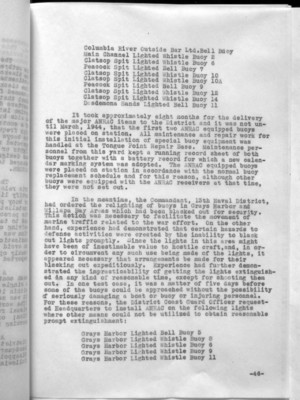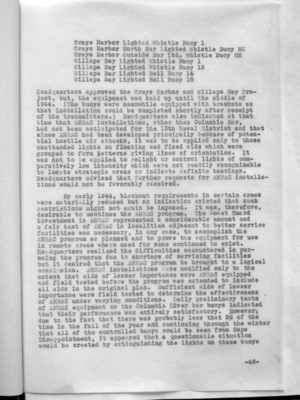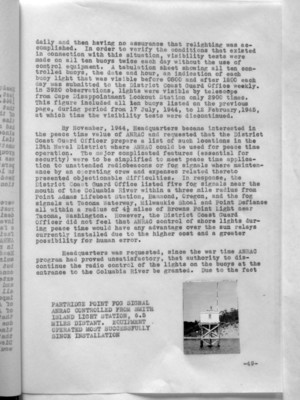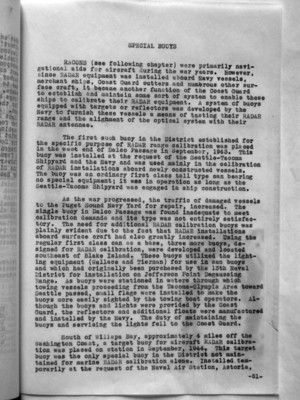Pages That Mention 13th Naval district
Coast Guard District narrative histories 1945
66
Columbia River Outside Bar Ltd.Bell Buoy Main Channel Lighted Whistle Buoy 2 Clatsop Spit Lighted Whistle Buoy 6 Peacock Spit Lighted Bell Buoy 7 Clatsop Spit Lighted Whistle Buoy 10 Clatsop Spit Lighted Whistle Buoy 10A Peacock Spit Lighted Bell Buoy 9 Clatsop Spit Lighted Whistle Buoy 12 Clatsop Spit Lighted Whistle Buoy 14 Desdemona Sands Lighted Bell Buoy 11
It took approximately eight months for the delivery of the major ANRAC items to the District and it was not until March, 1944, that the first two ANRAC equipped buoys were placed on station. All maintenance and repair work for this initial installation of special buoy equipment was handled at the Tongue Point Repair Base. Maintenance personnel from this yard kept a running record sheet of both buoys together with a battery record for which a new calendar marking system was adopted. The ANRAC equipped buoys were placed on station in accordance with the normal buoy replacement schedule and for this reason, although other buoys were equipped with the ANRAC receivers at that time, they were not set out.
In the meantime, the Commandant, 13th Naval District, had ordered the relighting of buoys in Grays Harbor and Willapa Bay Areas which had been blacked out for security. This action was necessary to facilitate the movement of marine traffic related to the war effort. On the other hand, experience had demonstrated that certain hazards to defense activities were created by the inability to black out lights promptly. Since the lights in this area might have been of inestimable value to hostile craft, and, in order to circumvent any such use being made of the lights, it appeared necessary that arrangements be made for their blacking out expeditiously. Experience had further demonstrated the impracticability of getting the lights extinguished in any kind of reasonable time, except for shooting them out. In one test case, it was a matter of five days before some of the buoys could be approached without the possibility of seriously damaging a boat or buoy or injuring personnel. For these reasons, the District Coast Guard Officer requested Headquarters to install ANRAC on the following lights where other means could not be utilized to obtain reasonable prompt extinguishment:
Grays Harbor Lighted Bell Buoy 5 Grays Harbor Lighted Whistle Buoy 8 Grays Harbor Lighted Whistle Buoy 6 Grays Harbor Lighted Whistle Buoy 9 Grays Harbor Lighted Whistle Buoy 11
-46-
68
Grays Harbor Lighted Whistle Buoy 1 Grays Harbor North Bar Lighted Whistle Buoy NC Grays Harbor Outside Bar Ltd. Whistle Buoy GH Willapa Bay Lighted Whistle Buoy 1 WIllapa Bay Lighted Whistle Buoy 12 Willapa Bay Lighted Bell Buoy 14 Willapa Bay Lighted Bell Buoy 18
Headquarters approved the Grays Harbor and Willapa Bay Project, but, the equipment was held up until the middle of 1944. (The buoys were meanwhile equipped with brackets so that installation could be completed shortly after receipt of the transmitters.) Headquarters also indicated at that time that ANRAC installations, other than Columbia Bar, had not been anticipated for the 13th Naval District and that since ANRAC had been developed principally because of potential hostile air attacks, it was to be applied only to those unattended lights on floating and fixed aids which were grouped to form patterns giving lines of orientation. It was not to be applied to relight or control lights of comparatively low intensity which were not readily recognizable to locate strategic areas or indicate definite bearings. Headquarters advised that further requests for ANRAC installations would not be favorably received.
By early 1944, blackout requirements in certain areas were materially reduced but no indication existed that such restrictions might not again be imposed. It was, therefore, desirable to continue the ANRAC program. The Coast Guard investment in ANRAC represented a considerable amount and a fair test of ANRAC in localities adjacent to better service facilities was necessary, in any case, to accomplish the ANRAC program as planned and to prove the equipment for use in remote areas where need for same continued to exist. Headquarters realized the difficulties encountered in pursuing the program due to shortage of servicing facilities but it desired that the ANRAC program be brought to a logical conclusion. ANRAC installations were modified only to the extent that aids of lesser importance were ANRAC equipped and field tested before the program was extended to include all aids in the original plan. Sufficient aids of lesser importance were field tested to determine the effectiveness of ANRAC under varying conditions. Daily preliminary tests of ANRAC equipment on the Columbia River bar buoys indicated that their performance was entirely satisfactory. However, due to the fact that there was probably less that 5% of the time in the fall of the year and continuing through the winter that all of the controlled buoys could be seen from Cape Disappointment, it appeared that a questionable situation would be created by extinguishing the lights on these buoys
-48-
69
daily and then having no assurance that relighting was accomplished. In order to verify the conditions that existed in connection with this situation, visibility tests were made on all ten buoys twice each day without the use of control equipment. A tabulation sheet showing all ten controlled buoys, the date and hour, an indication of each buoy light that was visible before 0800 and after 1200 each day was submitted to the District Coast Guard Office weekly. In 3920 observations, lights were visible by telescope from Cape Disappointment Lookout Station only 2900 times. This figure included all ten buoys listed on the previous page, during period from 17 July, 1944, to 12 February, 1945, at which time the visibility tests were discontinued.
By November, 1944, Headquarters became interested in the peace time value of ANRAC and requested that the District Coast Guard Officer prepare a list of such locations in the 13th Naval District where ANRAC could be used for peace time operation. The major complicated features (essential for security) were to be simplified to meet peace time application to unattended radiobeacons or fog signals where maintenance by an operating crew and expenses related thereto presented objectionable difficulties. In response, the District Coast Guard Office listed five fog signals near the mouth of the Columbia River within a three mile radius from Point Adams Lifeboat Station, Hammond, Oregon, and the fog signals at Tacoma Waterway, Milwaukie Shoal and Point Defiance all within a radius of 4 1/2 miles of Browns Point Light near Tacoma, Washington. However, the District Coast Guard Officer did not feel that ANRAC control of shore lights during peace time would have any advantage over the sun relays currently installed due to the higher cost and a greater possibility for human error.
Headquarters was requested, since the war time ANRAC program had proved unsatisfactory, that authority to discontinue the radio control of the lights on the buoys at the entrance to the Columbia River be granted. Due to the fact
(image)
PARTRIDGE POINT FOG SIGNAL ANRAC CONTROLLED FROM SMITH ISLAND LIGHT STATION, 6.5 MILES DISTANT. EQUIPMENT OPERATED MOST SUCCESSFULLY SINCE INSTALLATION
-49-
71
SPECIAL BUOYS
RACONS (see following chapter) were primarily navigational aids for aircraft during the war years. However, since RADAR equipment was installed aboard Navy vessels, merchant ships, Coast Guard cutters and numerous other surface craft, it became another function of the Coast Guard to establish and maintain some sort of system to enable these ships to calibrate their RADAR equipment. A system of buoys equipped with targets or reflectors was developed by the Navy to furnish these vessels a means of testing their RADAR range and the alignment of the optical system with their RADAR antennae.
The first such buoy in the District established for the specific purpose of RADAR range calibration was placed in the west end of Dalco Passage in September, 1943. This buoy was installed at the request of the Seattle-Tacoma Shipyard and the Navy and was used mainly in the calibration of RADAR installations aboard newly constructed vessels. The buoy was an ordinary first class tall type can bearing no special equipment; it was in operation as long as the Seattle-Tacoma Shipyard was engaged in ship construction.
As the war progressed, the traffic of damaged vessels to the Puget Sound Navy Yard for repair, increased. The single buoy in Dalco Passage was found inadequate to meet calibration demands and its type was not entirely satisfactory. The need for additional RADAR calibration buoys was plainly evident due to the fact that RADAR installations aboard surface craft had also greatly increased. Using the regular first class can as a base, three more buoys, designed for RADAR calibration, were developed and located southeast of Blake Island. These buoys utilized the lighting equipment (Wallace and Tiernan) for use in can buoys and which had originally been purchased by the 13th Naval District for installation on Jefferson Point Degaussing Range. As buoys were stationed in waters through which towing vessels proceeding form the Tacoma-Olympia Area toward Seattle passed, small flags were installed to make the buoys more easily sighted by the towing boat operators. Although the buoys and lights were provided by the Coast Guard, the reflectors and additional floats were manufactured and installed by the Navy. The duty for maintaining the buoys and servicing the lights fall to the Coast Guard.
South of Willapa Bay, approximately 4 miles off the Washington Coast, a target buoy for aircraft RADAR calibration was placed on station in September, 1944. This target buoy was the only special buoy in the District not maintained for marine RADAR calibration alone. Installed temporarily at the request of the Naval Air Station, Astoria,
-51-
76
Of all the ingenious war developments which were diverted to peace time use, RACON and LORAN were the two which effected safer navigation for air and surface craft and were, therefore, the concern of the Aids to Navigation Section, both during and after the war.
RACONS (formed by the contraction of RAdar and BeaCON and not to be confused with RACAN, the initial terminology for ANRAC equipment)¹ had been established during the war years at Air Stations or Light Stations (or activities where the need for them was evident) along the coasts of North America, from Greenland to the West Indies, in the Hawaiian Islands and the Canal Zone. Military agencies were the sole users of RACONS until the conclusion of the war, at which time the use of RADAR was permitted to commercial concerns and, consequently, dictated the post war expansion of the RADAR beacon installations. Although many RACONS were discontinued at Air Stations which the Army or the Navy abandoned, more were eventually established along the routes of commercial aircraft.
Both the Army and Navy awaited eagerly the completion of RADAR and, when it was perfected, began installing it, ashore and afloat. It was not, however, until the early months of 1943, that the RACON program reached the Northwest Coast. Early in that year, the Navy had determined to establish RACONS on Coast Guard Light Stations at Cape Arago, Charleston, Oregon, Cape Blanco, Port Orford, Oregon, heceta Head, Florence, Oregon, and Yaquina Head, Agate Beach, Oregon. As the aerial activity in the 13th Naval District had increased rapidly, the RACONS were located at highly important navigational points and were regarded as a responsibility comparable to that of a light or radiobeacon. No additional personnel were required for the RACONS as the equipment itself needed very little attention. Although a continuous watch was necessary, the radio-telephone watch was able to maintain and operated the RACONS without hindrance to their other assigned duties. Sixteen Coast Guardsmen from the above mentioned Light Stations were schooled in operation and maintenance of RACON equipment at the one week training course at the Naval Air Station, Seattle, a short time before the installations were completed.
The installation of these early RACONS was supervised by the Air Officer, Northwest Sea Frontier. All equipment, including the converted power supply and its installation, were supplied through the Radio Material Officer, 13th Naval District. The Coast Guard's responsibility was to assign
-56-




